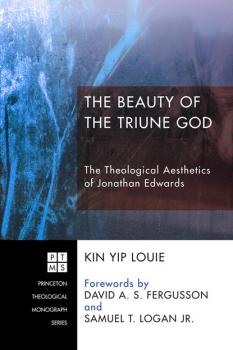ТОП просматриваемых книг сайта:
Princeton Theological Monograph Series
Скачать книги из серии Princeton Theological Monograph SeriesАннотация
The eighteenth-century Puritan theologian Jonathan Edwards has become popular again in contemporary theological discussion. Central to Edwards' theology is his concept of beauty. Delattre wrote the standard work on this topic half a century ago. However, Delattre approaches Edwards mainly as a philosopher, and he does not address how Edwards employs the concept of beauty to explain and defend traditional Reformed doctrines. Recent writings by McClymond, Holmes, and others have shown that defending the Reformed tradition is a fundamental concern of Edwards. This work reveals how Edwards, starting with the common notion that beauty means the appropriate proportional relationship, develops a theological aesthetic that contributes to a rational understanding of major doctrines such as the Trinity, Christology, and eschatology. It shows that Edwards is both an innovative speculative theologian and a staunch defender of Reformed orthodoxy.
Аннотация
In contrast to the popular notion that the doctrine of the Trinity hinders Christians from engaging with the reality of religious diversity, this book argues that the doctrine is the best way of constructing contemporary theology of religions. An Imaginative Glimpse reexamines three prominent Trinitarian theologians of religions (Raimundo Panikkar, Gavin D'Costa, and S. Mark Heim) and proposes a fresh and creative model by bringing the classical idea of perichoresis to its present-day multifaith situation.
Opening a new alternative in both Trinitarian theology and theology of religions, Adiprasetya's approach adds a distinctive contribution to the ongoing and challenging discussion in both fields. By using perichoresis imaginatively as a multidimensional category for multiple religious participations within the Trinity, Adiprasetya argues that the model is able to respect all religions on their own terms, while at the same time being faithful to the Christian standpoint.
Opening a new alternative in both Trinitarian theology and theology of religions, Adiprasetya's approach adds a distinctive contribution to the ongoing and challenging discussion in both fields. By using perichoresis imaginatively as a multidimensional category for multiple religious participations within the Trinity, Adiprasetya argues that the model is able to respect all religions on their own terms, while at the same time being faithful to the Christian standpoint.
Аннотация
Throughout the Bible, divine interaction with humanity is portrayed in almost embarrassingly human terms. He sees, hears, thinks, feels, runs, rides chariots, laughs, wields weapons, gives birth, and even repents. Many of these expressions, taken at face value, seem to run afoul of much classical theology, including divine simplicity, transcendence, omniscience, omnipotence, omnipresence, and especially immutability.
Traditionally, these texts have been seen as «accommodations» to human intellectual and moral limitations. That is, they were deemed as giving God a more approachable feel, but not as representing any «real» part of his character, being, or interaction with humanity. For example, references to God seeing or hearing are not deemed to represent real acts, as God already knows everything.
However, this view is largely based on an Aristotelian conception of metaphors as rhetorical devices, not vehicles that carry any truth content. Since the 1970s, the understanding of how metaphors convey meaning has taken great strides. These advances can help unlock how divine action–often inadvertently flattened under theological presuppositions–functions within a text.
This book aims to explore the biblical metaphor of divine sight and how current understandings of metaphorical function can enrich our reading of the text and its theology.
Traditionally, these texts have been seen as «accommodations» to human intellectual and moral limitations. That is, they were deemed as giving God a more approachable feel, but not as representing any «real» part of his character, being, or interaction with humanity. For example, references to God seeing or hearing are not deemed to represent real acts, as God already knows everything.
However, this view is largely based on an Aristotelian conception of metaphors as rhetorical devices, not vehicles that carry any truth content. Since the 1970s, the understanding of how metaphors convey meaning has taken great strides. These advances can help unlock how divine action–often inadvertently flattened under theological presuppositions–functions within a text.
This book aims to explore the biblical metaphor of divine sight and how current understandings of metaphorical function can enrich our reading of the text and its theology.
Аннотация
When in the sixth century Dionysius the Areopagite declared beauty to be a name for God, he gave birth to something that had long been gestating in the womb of philosophical and theological thought. In doing so, Dionysius makes one of his most pivotal contributions to Christian theological discourse. It is a contribution that is enthusiastically received by the schoolmen of the Middle Ages, and it comes to permeate the thought of scholasticism in a multitude of ways. But perhaps nowhere is the Dionysian influence more pronounced than in the thought of Thomas Aquinas.
This book examines both the historical development of beauty's appropriation as a name for God in Dionysius and Thomas, and the various contours of what it means. The argument that emerges from this study is that given the impact that the divine name theological tradition has within the development of Christian theological discourse, beauty as a divine name indicates the way in which beauty is most fundamentally conceived in the Christian theological tradition as a theological theme. As a phenomenon of inquiry, beauty proves itself to be enigmatic and elusive to even the sharpest intellects in the Greek philosophical tradition. When it is absorbed within the Christian theological synthesis, however, its enigmatic content proves to be a powerful resource for theological reasoning.
This book examines both the historical development of beauty's appropriation as a name for God in Dionysius and Thomas, and the various contours of what it means. The argument that emerges from this study is that given the impact that the divine name theological tradition has within the development of Christian theological discourse, beauty as a divine name indicates the way in which beauty is most fundamentally conceived in the Christian theological tradition as a theological theme. As a phenomenon of inquiry, beauty proves itself to be enigmatic and elusive to even the sharpest intellects in the Greek philosophical tradition. When it is absorbed within the Christian theological synthesis, however, its enigmatic content proves to be a powerful resource for theological reasoning.
Аннотация
Luther's theology of the cross is a direct critique of oppressive power relationships in his day. Luther's early thought challenges specific economic, political, social, ideological, and religious power dynamics; the cross confronts those who enjoy power, prestige, pomp, and profits at the expense of the poor. Ruge-Jones maps the power relationships that Luther's theology addressed and then turns to specific works that challenge established structures of his world. Luther's Latin texts undermine the ideological assumptions and presumptions that bolstered an opulent church and empire. Luther uses the cross of Christ to challenge what he called volatilem cogitatum, «knowledge that is prone to violence.» His German writings (directed to a broader, more popular audience) focus this critique of human pretensions into an attack on systems of wealth, status, and power that refuse to look with compassion upon poor Mary, or upon the many domestic servants of Germany. God has respected the ones whom the world disrespects and has thus entered the world to turn it upside down. Also in the German writings, the Lord's Supper calls the powerful to enter into solidarity with the poor–suffering people to whom Christ has given himself. Finally, in his popular pamphlets, visual images show with graphic specificity that throughout his life Christ sought out solidarity with the least. These images contrast brutally with images of a church that has sold its soul to wealth, political influence, military power, and status.
Аннотация
Count Nikolaus Ludwig von Zinzendorf was without question the most influential German theologian between Luther and Schleiermacher. He was the force behind modern Protestant missions, launched efforts that eventually became the ecumenical movement, and influenced some of the most significant theological projects of the modern world from Schleiermacher's to Barth's and Bonhoeffer's.
He was convinced that in important respects the Christian church of his day had lost its way both intellectually and practically. In these speeches, given to overflow crowds in Berlin, he brought to expression what he held to be the absolute and nonnegotiable center of Christian existence-the main thing. Here he laid out for public view the heart of all his activity, the guiding reality of his life. In these speeches Zinzendorf focuses on fundamental theological themes. One senses the influence upon him of the Pietist movement and of Orthodox theology. One gains an appreciation for his bold idiosyncrasy, his willingness to stand apart, and to bear witness. But above all, one gains here an insight into the very heart of Zinzendorf.
He was convinced that in important respects the Christian church of his day had lost its way both intellectually and practically. In these speeches, given to overflow crowds in Berlin, he brought to expression what he held to be the absolute and nonnegotiable center of Christian existence-the main thing. Here he laid out for public view the heart of all his activity, the guiding reality of his life. In these speeches Zinzendorf focuses on fundamental theological themes. One senses the influence upon him of the Pietist movement and of Orthodox theology. One gains an appreciation for his bold idiosyncrasy, his willingness to stand apart, and to bear witness. But above all, one gains here an insight into the very heart of Zinzendorf.
Resurrection, Apocalypse, and the Kingdom of Christ - Stanley S. MacLean
Princeton Theological Monograph SeriesАннотация
In recent decades few Christian themes have attracted as much attention as that of eschatology, or Christian hope. Resurrection, Apocalypse, and the Kingdom of Christ explores the meaning of this theme for Thomas F. Torrance, one of the twentieth-century's leading theologians. This study, the first of its kind, brings Torrance's eschatology to light through an exploration of the whole range of his corpus, including sermons, lectures, and correspondence. It also demonstrates that his eschatology is molded by momentous historical events such as World War II, the spread of communism, and the ecumenical movement. Out of all this, we realize that eschatology is a central component of Torrance's theology–so much so that it conditions his thinking on other Christian doctrines.
Аннотация
At a time when the fractious legacy of the Protestant Reformation is coming under new scrutiny, Anthony Siegrist explores the implications of ecumenism for believers' baptism. Writing from within the tradition of the Radical Reformation, he challenges dominant ecclesiological assumptions and argues that this central practice needs to be reconstrued. Siegrist works constructively to develop a concrete account of believers' baptism that attends closely to the dynamics of divine initiation. Siegrist deliberately stretches the traditional Anabaptist conversation to include not just expected voices like Yoder and Marpeck, but also luminaries from the broader Christian tradition; Barth, Bonhoeffer, and a variety of ancient sources are creatively engaged. The intent of Participating Witness is eminently practical, but its argumentation is carried out with theological rigor.








